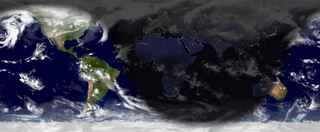June 22: Among other things, it’s the anniversary of the Germans’ invasion of the Soviet Union in 1941 and the birthdays of a couple good friends, Dan and George, whom I haven’t seen in a long time. I always think of those three things on this date.
It’s also the date that, up here in the Northern Hemisphere, daylight starts bleeding away after the summer solstice. At my latitude (a bit below the 38th Parallel), one rather complete reference, timeanddate.com, reports that we’ll have about two seconds less daylight today than yesterday (the daily shrinkage is greater the farther north you go). Tomorrow, six seconds less; a week from tomorrow, 29 seconds less, a week after than, 50 seconds less. Here, the sun will set after 8 p.m. until mid-August. It’s about then, when the daylight is shrinking by two minutes a day, that I always feel that I start to notice it.
Some of the math that goes into determining the length of daylight is here, a 1998 post at the Ask Dr. Math forum. And a very cool-looking Java applet that spits out daylight data for any point on the Earth’s surface is here: Daylight Applet (it takes a while to calculate your data; there’s also a paid, dowloadable version that gives you a lot more numbers and tables).

